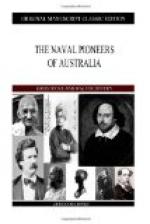Other splendid service of Bligh is related in the following letter, which was printed in the Daily Graphic under date London, October 28th, 1897. The letter was signed “Mary Nutting (nee Bligh), widow of the late rector of Chastleton, Oxon., Beausale House, Warwick,” and as it is a spirited defence of a naval officer whose personal character has been impugned by these present writers as well as many others, we reprint the letter in full:—
“Sir,—There are special circumstances relating to the event of the battle of Camperdown, the centenary of which was recently commemorated, which have never been made public. One is the duel fought between the Director and the Vryheid, in which the Dutch ship was dismasted and destroyed—a naval duel at which no other ship on either side was present, or within reach or sight. On the previous day (October 11th, 1797) the English and Dutch fleets had met, fought, and the Dutch ships were dispersed, or, as you stated, ‘their line was broken.’ The Dutch admiral and his ship, however, escaped, and, no doubt, would have again been seen at sea had it not been that on October 12th, 1797, the Director came up with the Vryheid, and having, after a severe struggle, first silenced and then boarded her, the Dutch admiral went on board the English ship, and gave up his sword to the captain. The captain was Captain (afterwards Admiral) W. Bligh. Strange to say, in the despatches sent home by Admiral Duncan Captain Bligh was not mentioned. I have three large water-colour pictures taken from sketches done by an artist on board the Director at the time of the battle, showing the Director coming up and attacking the Vryheid, the engagement at its height, and, finally, the Vryheid dismasted and a wreck. Bligh was a man whose service was great, and, although in due course he became an admiral, he received no special reward from his country. In his earlier years, at the age of nineteen, he was selected by Sir Joseph Banks, his friend through life, to serve with Captain Cook as master on board the Resolution, in the year 1774, and sailed for four years on three voyages with him. After Captain Cook’s death the navigation of the ship devolved on Bligh, who brought her home. After this, for four years, as commander, he traversed unknown seas. He fought under Admiral Parker at the Doggerbank, and under Lord Howe at Gibraltar. After the battle of Copenhagen, where Bligh commanded the Glatton, he was sent for by Lord Nelson to receive his thanks publicly on his quarter-deck, and the words of the great hero were—’Bligh, I thank you; you have supported me nobly.’ In the time of the mutiny at the Nore, he rendered great services by his courage and energetic efforts, recalling many of the rebellious sailors to their duty and allegiance.
“After the mutiny of the Bounty, Bligh, with wonderful skill and courage, brought




